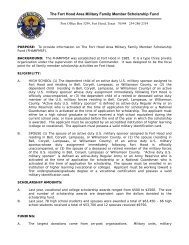Testing in a Joint Environment Roadmap - U.S. Army Operational ...
Testing in a Joint Environment Roadmap - U.S. Army Operational ...
Testing in a Joint Environment Roadmap - U.S. Army Operational ...
Create successful ePaper yourself
Turn your PDF publications into a flip-book with our unique Google optimized e-Paper software.
For Official Use Only<br />
<strong>Test<strong>in</strong>g</strong> <strong>in</strong> a Jo<strong>in</strong>t <strong>Environment</strong> <strong>Roadmap</strong><br />
models, tools and utilities, a data archive capability, and a reuse repository. This required<br />
<strong>in</strong>frastructure is also the most costly element needed to achieve the vision of test<strong>in</strong>g <strong>in</strong> a jo<strong>in</strong>t<br />
environment.<br />
B.2.3.1 PERSISTENT DATA TRANSPORT CAPABILITY<br />
The Persistent Data Transport Capability provides wide-area connectivity between<br />
geographically-dispersed development laboratories, Department of Defense (DoD) <strong>in</strong>dustry<br />
laboratories, test facilities, simulation centers, and ranges as well as any other site l<strong>in</strong>ked to the<br />
jo<strong>in</strong>t mission <strong>in</strong>frastructure. The Persistent Data Transport Capability is not a new DoD network.<br />
Instead, the capability will be created by us<strong>in</strong>g exist<strong>in</strong>g and emerg<strong>in</strong>g DoD networks, <strong>in</strong>clud<strong>in</strong>g<br />
Secret Internet Protocol Router Network (SIPRNET), Defense Information System Network<br />
Asynchronous Transfer Mode Services – Unclassified/Classified (DATMS-U/C), DISN Lead<strong>in</strong>g<br />
Edge Services (DISN-LES), Defense Research and Eng<strong>in</strong>eer<strong>in</strong>g Network (DREN), and<br />
ultimately, the Global Information Grid – Bandwidth Expansion (GIG-BE). Function<strong>in</strong>g like a<br />
virtual private network (VPN) or collection of VPNs, the Persistent Data Transport Capability<br />
will be an established “community of <strong>in</strong>terest” on these exist<strong>in</strong>g DoD networks, allow<strong>in</strong>g the<br />
security accreditation processes to be streaml<strong>in</strong>ed. For sites that do not have connectivity on one<br />
of the approved DoD networks, the exist<strong>in</strong>g networks will be appropriately extended to satisfy<br />
the requirements for that site to be <strong>in</strong>corporated <strong>in</strong>to the jo<strong>in</strong>t mission <strong>in</strong>frastructure. The<br />
Persistent Data Transport Capability will build upon and <strong>in</strong>teroperate with the data transport<br />
solution for the JNTC, so that Jo<strong>in</strong>t Forces Command (JFCOM) tra<strong>in</strong><strong>in</strong>g exercises can be<br />
leveraged to generate the jo<strong>in</strong>t mission environment for test<strong>in</strong>g.<br />
B.2.3.2 COMMON MIDDLEWARE<br />
The Common Middleware is the high-performance, real-time, low-latency communication<br />
<strong>in</strong>frastructure used by applications and tools dur<strong>in</strong>g execution for all communication between<br />
systems. Provid<strong>in</strong>g a unified <strong>in</strong>terface to all software applications, the Common Middleware<br />
will have features for creat<strong>in</strong>g, manag<strong>in</strong>g, publish<strong>in</strong>g, and delet<strong>in</strong>g distributed objects (with state<br />
<strong>in</strong>formation), publish/subscribe messag<strong>in</strong>g, and data streams (e.g., tactical data l<strong>in</strong>ks, video,<br />
audio, raw telemetry, etc.). Furthermore, it will have services to support manag<strong>in</strong>g distributed<br />
objects <strong>in</strong> the exercise, such as access control and data <strong>in</strong>tegrity to ma<strong>in</strong>ta<strong>in</strong> consistency across<br />
distributed systems. It will support many different strategies for communication, <strong>in</strong>clud<strong>in</strong>g typebased<br />
subscription, <strong>in</strong>terest-based subscription, multi-cast, "best effort," and reliable delivery,<br />
each with various qualities of service associated with them. The Common Middleware will<br />
support numerous communication media, such as conventional IP networks, wireless networks,<br />
shared memory, and reflective memory, and will be optimized to work over the Persistent Data<br />
Transport Capability. The Common Middleware will be based upon best commercial practices;<br />
however, it will be designed to easily <strong>in</strong>corporate new and advanc<strong>in</strong>g data distribution<br />
technologies with m<strong>in</strong>imal impact to compliant applications. S<strong>in</strong>ce the Common Middleware is<br />
B-5<br />
For Official Use Only<br />
Appendix B






